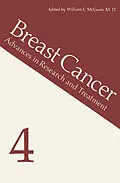This is the fourth book in a series dealing with breast cancer. Volumes 1-3 were concerned with treatment, experimental biology, and a number of varied timely topics. The present volume continues to review the breast cancer field in the broadest sense. The first chapter addresses the question of selecting appropriate chemotherapy for the patient. In the 1970s, great advances were seen in our ability to achieve objective tumor regression with empirical combina tions of chemotherapeutic agents. The next decade will focus on precise methods to select those agents likely to have the greatest benefit in individual patients. Livingston has provided us with a thorough review of the current state of the art. We have known for some time that steroid hormone receptor assays of considerable value to clinicians caring for patients with advanced disease. Osborne and colleagues now present considerable arguments that receptor assays are also useful in the setting of primary breast cancer for purposes of both prognosis and treatment strategy. A very important clinical problem which has received little attention in the research laboratory is benign breast disease. If one inquires about the medical therapy of this disorder in the United States, it is obvious that the majority of physicians would appreciate a better understanding of the pathophysiology which might lead to improved therapies. Mauvais-Jarvis and co-workers provide us with such an account from their wide experience.
Inhalt
1. Methods to Predict Response to Chemotherapy.- 1. General Considerations.- 1.1. In Vivo-Xenograft Systems.- 1.2. In Vitro.- 2. In Vitro Predictive Systems.- 2.1. Systems Based on Primary Site of Action.- 2.2. Systems Based on Metabolic Changes.- 2.3. Systems Based on Morphological Changes.- 2.4. Systems Based on Drug Uptake or Activation.- 2.5. Systems Based on Loss of Reproductive Integrity.- 3. Current Areas of Promise.- 3.1. Labeling-Index Perturbation.- 3.2. Clonogenic ("Stem-Cell") Assay.- 4. Design and Direction of Future Studies.- 4.1. Pharmacological Considerations Generally Applicable to in Vitro Testing.- 4.2. Future Directions.- 5. The Significance of Success.- 6. References.- 2. Estrogen Receptor and Prognosis in Breast Cancer.- 1. Introduction.- 2. Factors That Influence Prognosis in Primary Breast Cancer.- 3. Rationale for Estrogen Receptor as a Prognostic Indicator.- 4. Clinical Studies of Estrogen Receptor and Prognosis.- 5. Implications for Treatment.- 6. Conclusion.- 7. References.- 3. Benign Breast Disease.- 1. Introduction.- 2. Histopathology of Benign Breast Disease.- 2.1. Structure of the Normal Mammary Gland.- 2.2. Pathology of Benign Breast Disease.- 3. Hormone Dependence of Benign Breast Disease.- 3.1. Normal Breast.- 3.2. Experimental Data.- 3.3. Ovarian Function in Women with Benign Breast Disease.- 3.4. In Vitro Studies in Benign Breast Disease.- 3.5. Hormonal Treatment of Benign Breast Disease.- 3.6. Pathophysiological Interpretation of the Hormonal Abnormalities Observed in Women with Benign Breast Disease.- 4. Relationship between Benign Breast Disease and Breast Cancer.- 5. Role of Exogenous Estrogens in the Incidence of Benign Breast Disease.- 5.1. Oral Contraceptives.- 5.2. Estrogen Treatment of Menopausal Women.- 6. Conclusions.- 7. References.- 4. A Patient Looks at Breast Cancer at the Beginning of a New Decade.- 1. Prologue.- 2. Introduction.- 3. The "State of the Art" in 1970.- 3.1. Biology.- 3.2. Etiology and Epidemiology.- 3.3. Detection and Diagnosis.- 3.4. Primary Treatment.- 3.5. Adjuvant Therapy.- 3.6. Metastatic Disease.- 3.7. Psychosocial Aspects of Breast Cancer.- 4. The "State of the Art" in 1980.- 4.1. Biology.- 4.2. Etiology and Epidemiology.- 4.3. Detection and Diagnosis.- 4.4. Primary Treatment.- 4.5. Adjuvant Therapy and Metastatic Disease.- 4.6. Psychosocial Aspects of Breast Cancer.- 5. References.- 5. Breast Cancer Detection Center Projects.- 1. Inception and Organization.- 2. Second Thoughts.- 3. The Beahrs Report.- 4. The Course of Events.- 5. Follow-up.- 6. Pathology Review.- 7. Conclusion.- Appendix I.- Appendix II.- Appendix III.- Appendix IV.- 8. References.- 6. Reconstruction of the Female Breast after Mastectomy.- 1. Introduction.- 2. Initial Interview.- 3. Alternative Types of Reconstruction Today.- 3.1. Revision of a Scar.- 3.2. Reduction of the Remaining Breast.- 3.3. Insertion of the Prosthesis Only.- 3.4. Use of a Special Prosthesis.- 3.5. Reconstruction of the Areolar Nipple Complex.- 3.6. Combination of These Methods.- 3.7. Microsurgical Methods of Reconstruction.- 3.8. Immediate Reconstruction.- 3.9. Myocutaneous Flap.- 4. Chemotherapy.- 5. Who Should Be Reconstructed?.- 6. Follow-up after Reconstructive Surgery.- 7. The Other Breast.- 8. Conclusion.- 9. Reading List.- 7. The High-Risk Woman.- 8. Comparative Pathological Study of Breast Carcinoma among American and Japanese Women.- 1. Introduction.- 2. Material and Methods.- 2.1. Tumor Size and Lymph-Node Metastasis.- 2.2. Ten-Year Survival Rate.- 3. Histological Classification.- 4. Results.- 4.1. Case Distribution.- 4.2. Ten-Year Survival Rate.- 5. Discussion.- 6. Conclusion.- 7. References.
